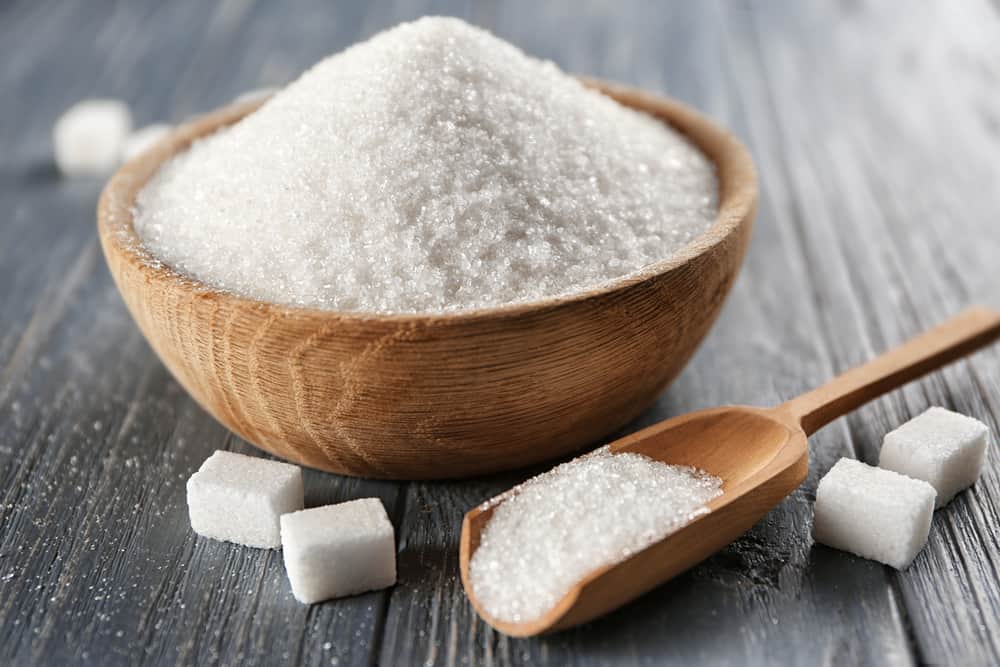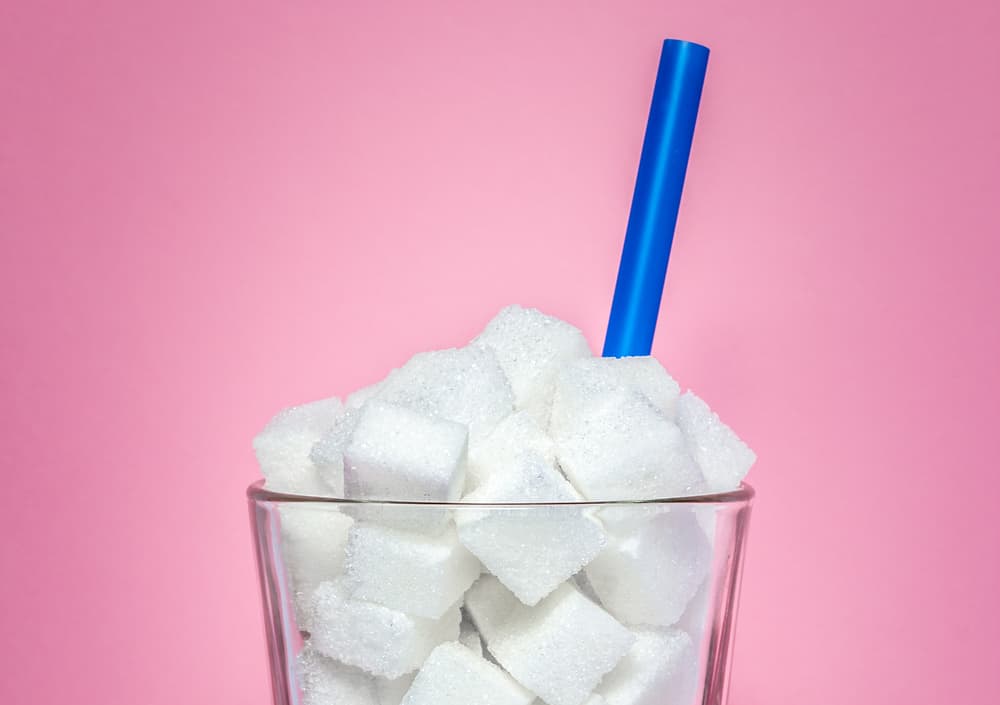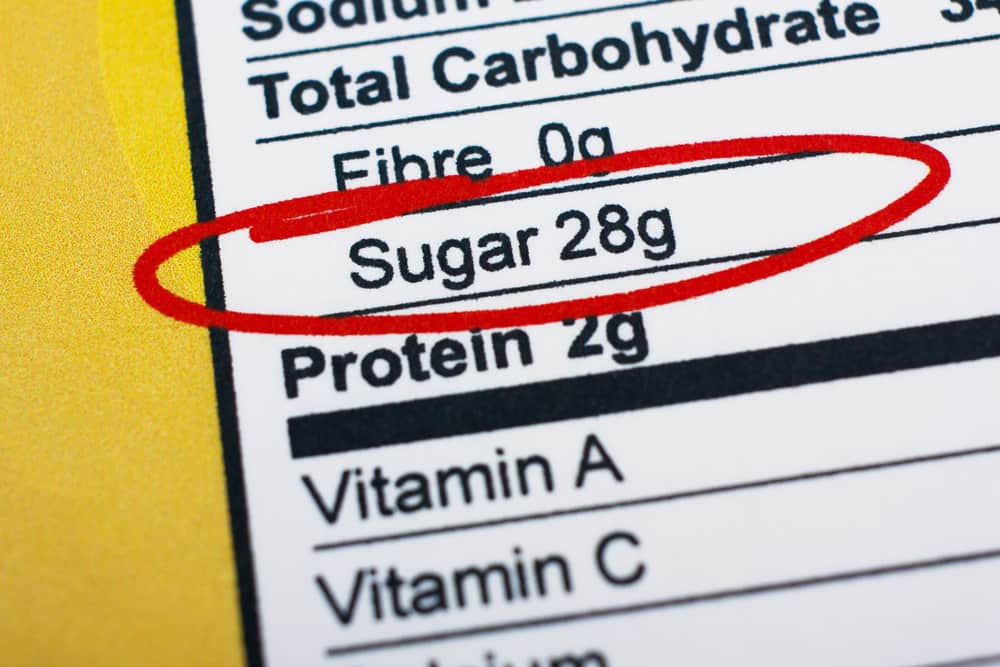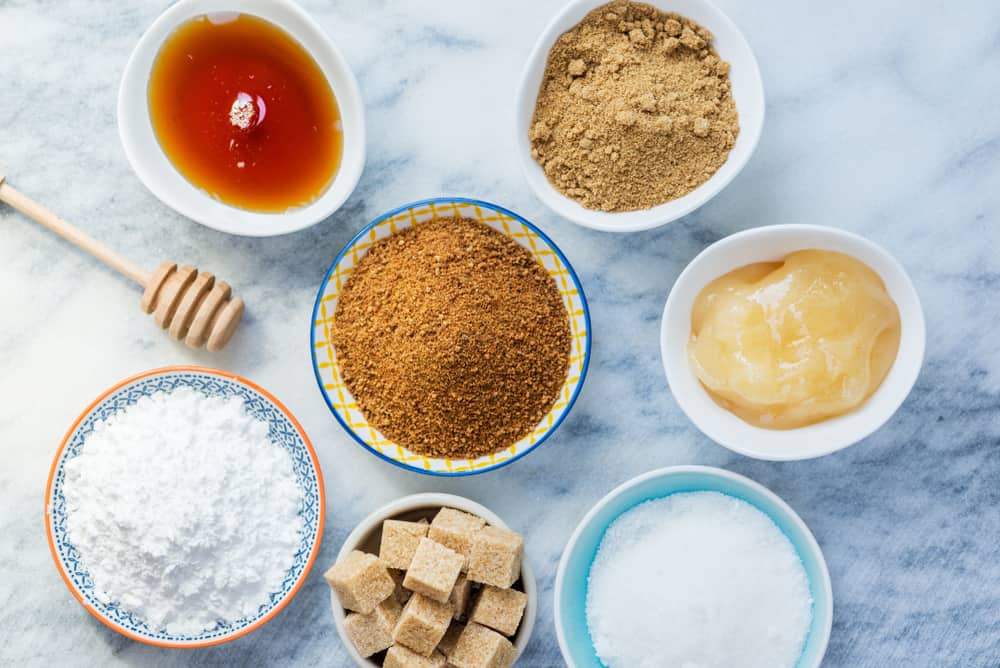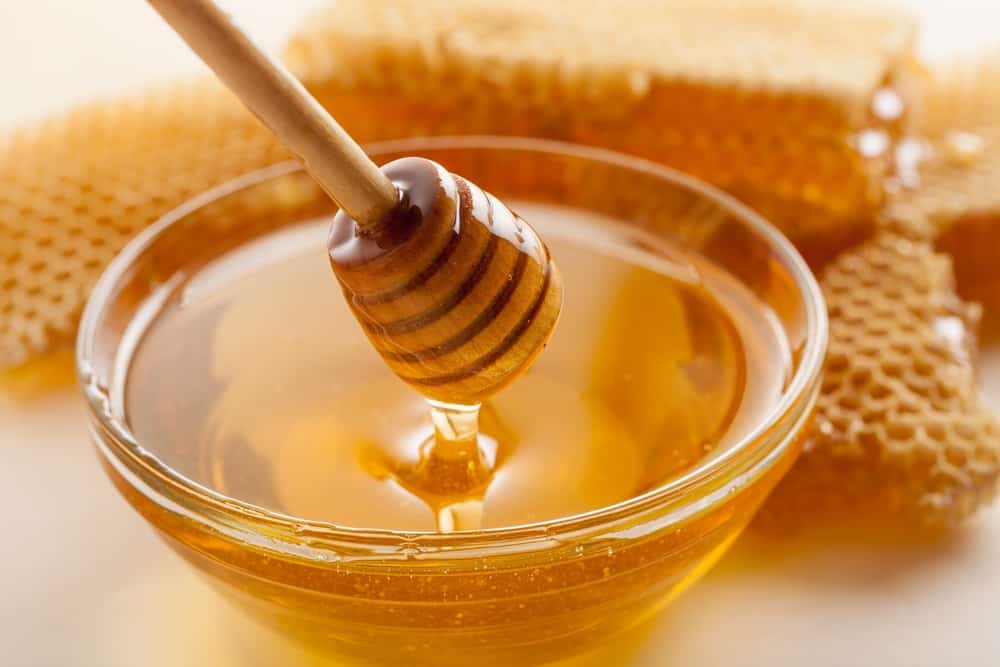Thinking About Quitting Sugar: 13 Tips to Get You Started
If you are thinking about quitting sugar or reducing sugar consumption, it is a terrific idea. There are excellent reasons to stop eating sugar, but let’s first explore those reasons and then understand the information needed to identify sugars. With that knowledge, it is possible to adjust to a healthier lifestyle and become a “sugar-free” person.
Know Your Daily Limits
The American Heart Association reports that the average American consumes 19 teaspoons of sugar per day, which equals approximately 62 pounds of sugar per year. The New Hampshire Department of Health and Human Services reports sugar consumption at a much higher figure, saying an average American eats 42.5 teaspoons of sugar per day, which equals approximately 152 pounds of sugar per year!
These amounts are more than twice, and up to four and one-half times, the recommended amounts for adult sugar consumption to maintain a healthy diet.
The World Health Organization (WHO) recommends limiting sugar consumption to 10% of daily calories and lowering this level to 5% or less for optimal health. Recommended daily calorie intakes in the Dietary Guidelines for Americans are around 2,500 for men and 2,000 for women under 50, and 1,400 for women over 50.
One teaspoon of refined white sugar is four grams, which equals approximately 15 calories. The American Heart Association recommends a daily sugar limit of nine teaspoons for men and six teaspoons for women.
To put this into perspective, a single serving of a 12-ounce regular soda, or a sugar-sweetened beverage such as an iced tea, contains eight teaspoons to 11 teaspoons of sugar. One can of a sugary drink is an entire day’s recommendation. The Center for Disease Control (CDC) reports that U.S. adults consume 145 calories of sugar daily just from sugar-sweetened beverages.
If sugar was only found in things as easily identifiable as a can of soda, it might be easier to limit sugar intake or eliminate sugar from the diet. The problem is that when quitting sugar, it is the most common additive found in almost all processed foods.
That is why it can be so useful to have a program like Noom that can help you with food logging. We love the fact that their database contains 1 million different foods and 1 million scannable barcode items. Right now, you can gain access to these features from Noom by checking out their free trial offer.
Sugar is in Almost Everything
When quitting sugar, it is surprising to discover how many processed foods contain the ingredient. Many are items that an average consumer may not recognize as something that is sweetened by added sugars.
Sometimes, products marketed as low-fat, lite, or reduced-fat have more sugar than the regular versions. When fat is removed, product taste suffers, so sugar is added to make it taste better.
We all can guess that sugary cereals marketed to children contain a lot of sugar. However, did you know that some of them have three teaspoons in a 34-gram serving? That means that more than one-third of the product is sugar.
Here are surprising things containing sugar with the amount the average amount that the USDA FoodData Central reports that they may include:
- Baked Beans: One cup of baked beans contains about five teaspoons of sugar.
- Barbecue Sauce: Two tablespoons of barbecue sauce may contain one teaspoon of sugar.
- Canned Soup: Premade soup has natural sugars and added sugars that may be a “hidden” sugar that goes by another name, such as barley malt, dextrose, maltose, sucrose, or high fructose corn syrup. They may have more than one, and the amounts add up.
- Gourmet Flavored Coffee: A cup of flavored coffee from a coffeehouse may contain up to 11 teaspoons of sugar.
- Granola: Granola is seen by many as “healthy” food, but it may contain honey and other sweeteners. Half a cup of granola has up to seven teaspoons of sugar.
- Ketchup: One tablespoon of ketchup contains one teaspoon of sugar.
- Low-Fat Yogurt: Many health-conscious people like yogurt for its probiotics. However, a cup of yogurt may contain up to 11 teaspoons of sugar. This is more sugar than found in a regular can of soda!
- Protein Bars: “Healthy” protein bars may contain up to five teaspoons of sugar. This makes them similar to a regular candy bar.
- Smoothies: Commercially-produced smoothies may contain up to 13 teaspoons of sugar in a 16- or 20-ounce serving.
- Spaghetti Sauce: Spaghetti sauce contains natural sugars from tomatoes and may also contain added sugar for taste. A 24-ounce can might have up to eight and a half teaspoons of sugar.
- Sports Drinks: Sports drinks are loaded with sugar. A 20-ounce bottle may contain nine teaspoons or more of sugar.
- Vitaminwater: This “healthy” drink may contain nearly eight teaspoons of sugar.
When trying to stop eating sugar, allow extra time to read ingredients lists on the items while you’re shopping. You will be shocked by how many things contain sugar.
How Addictive is Sugar?
A review of the scientific literature entitled Sugar addiction: is it real? found that in animal studies, consumption of sugars produced drug-like effects that include:
- Bingeing: This is the excessive consumption of something.
- Craving: This is an intense desire that is a symptom of withdrawal.
- Cross-Dependence: This is the ability of one drug to reduce the withdrawal symptoms from stopping another drug’s use.
- Cross-Sensitization: This occurs when sensitization to a stimulus is widened to include related stimuli. This increases a specific response to the original and the corresponding stimulus.
- Cross-Tolerance: This is a type of drug tolerance that comes from using another drug with similar effects.
- Tolerance: Tolerance is the diminished response to taking a substance over time that requires an increased dosage to achieve the same effect.
- Withdrawal: Withdrawal is the discomfort experienced upon suddenly stopping the chronic use of a substance.
Additionally, sugars’ ability to trigger the release of natural opioids might be the cause of the addiction, making it difficult to stop eating sugar. Sugar may mimic drug abuse from the point of view of brain neurochemistry and behaviors.
Research published in Current Opinion in Clinical Nutrition and Metabolic Care into sugar addiction notes that sugar and sweetness induce reward and craving comparable to addictive products.
On a neurobiological level, this may derive from a historical evolutionary pressure to find foods high in sugar and calories when foraging. This could explain why so many people have a challenging time controlling their consumption of foods containing sugar if they are continuously exposed to them, especially if this exposure started early.
An Alternative Explanation for the Animal Studies on Sugar Addiction
Some scientific researchers disagree with the conclusions about sugar addiction and how to stop eating sugar. In a published paper entitled Sugar addiction: the state of the science, researchers conclude that there is insufficient evidence of sugar addiction in humans because studies about this are inconclusive.
There are few addiction studies about humans who stop eating sugar and what happens from quitting sugar. They provide an alternative explanation for the results from animal studies and attribute the bingeing behavior of the sugar consumption by laboratory rats to be caused by the intermittent access to sugar, not by any neurochemistry in the brain.
In a layperson’s terms, the scientists noted that the rats were first trained to like sugar. When they do not get it for an extended period, its sudden reintroduction caused them to consume large quantities. The scientists think the rats consumed lots of sugar water because they were hungry, not from a craving caused by sugar’s neurochemical effects in the rats’ brains.
Sugar and Health Conditions
Sugar is highly rewarding in terms of taste and caloric input. However, excessive sugar consumption may cause the brain’s neurochemistry to adapt and disassociate eating from caloric requirements. This creates a sugar craving and might be the cause of some compulsive-eating behaviors.
The problem with sugar is more than occasional overeating. According to Frontiers in Bioscience, excessive sugar intake may cause many health problems such as weight gain, inflammatory conditions, and adverse metabolic syndrome. Caloric intake reduction, by reducing sugar intake, usually positively impacts a person’s health.
How to Read Nutrition Labels
The FDA published a guide on how to understand nutrition labels. There are four sections of information on the nutrition label: serving information, calories, nutrients, and % daily value (DV).
Serving Information
Serving information is shown in the area at the top of the nutrition label. It shows the number of servings per container and the serving size, expressed American-style measurements and metric sizes.
It may be easy to be fooled when reading this information because the serving size is only a portion of the contents. A serving size is standardized among brands of products in the same category.
For example, the standard serving size for potato chips is one ounce, equal to about 15 chips. An eight-ounce bag of potato chips contains eight servings of one-ounce each. Confusion may arise if a person thinks the nutrition label gives the information for the bag’s entire contents when the label is only for one-eighth of the bag’s contents.
Why is this important? Potato chips are salty, not sugary, right?
Although this is true, they are also loaded with refined carbohydrates that are similar to sugars. A single serving of potato chips may have 120 calories, 2 grams of fat, 23 grams of carbohydrate, and 2 grams of sugar. If a person eats a whole bag of chips, this is eight times that amount, equal to 960 calories, 16 grams of fat, 184 grams of carbohydrate, and 16 grams of sugar.
In this example, one bag of chips has a calorie count of nearly half the daily recommended allowance of 2,000 calories.
Calories
The calories per serving are listed in a large type font. Be careful to multiply the calorie count times the number of servings if you eat the entire contents of a package. The daily recommended allowance of 2,000 calories is the average, which is important to factor in when reducing or quitting sugar intake.
A specific person’s daily caloric needs depend on their age, gender, height, weight, and physical activity level. You can use a USDA guide to estimate caloric needs.
Nutrients
In this section on the label, you will see the amount of total fat, cholesterol, sodium, total carbohydrate, and protein. Below is a listing of minerals and vitamins in the product. The amounts are given in weight, such as grams (g), milligrams (mg), and micrograms (mcg). There is also a percentage of daily value shown as % DV.
For those concerned about sugar content, pay attention to the total sugars and the added sugars. Total sugars include the natural sugars found in a product and any added sugars. Also, pay attention to the total carbohydrates because these are naturally occurring simple and complex sugars, like flour, starches, and processed grains.
The FDA recommends that you look for the nutrients you want to get more of, like dietary fiber, calcium, iron, potassium, and vitamin D, and steer clear of those you may wish to reduce for better health, like added sugars, saturated fat, and sodium.
% Daily Value (DV)
The percentage (%) daily value is the amount that a category contributes to public health experts’ recommendations about the upper or lower limits for each nutrient listed. These figures are based on a 2,000-calorie daily diet. If you follow this dietary advice, you will stay within experts’ guidelines.
A low level of a nutrient per serving is 5% DV, and a high level is 20% DV. In general, the FDA recommends that consumers look for a lower % DV for added sugars, saturated fat, and sodium. Most consumers should look for a higher % DV for good things such as dietary fiber, calcium, iron, potassium, and vitamin D.
Like total sugars and trans fats, some ingredients do not have a % DV because the FDA has not established these levels.
The FDA recommends that consumers use % DV to make comparisons of different foods. Make sure the serving size is equal, then choose products with a greater % DV for nutrients you want and a lower % DV for nutrients you wish to reduce.
By making comparisons using the nutritional labels, consumers can avoid being fooled by marketing words such as “low fat,” “lite,” “reduced,” or “no fat.” These marketing labels can be confusing.
For example, breakfast cereals labeled as “whole grain,” “vitamin-enriched or fortified with vitamins,” and “are a part of a healthy breakfast” and may contain up tons of other unsavory ingredients and additives. Moreover, a product that contains no fat can be very fattening if it is full of sugars since the body converts excessive calories from sugars into fat.
A program like Noom can also help you keep track of your daily values. We love this program in particular because they have over a million foods in their food logging database. Plus, Noom offers 1:1 coaching, custom meal plans, and exercise tracking, so make sure to check out their free trial offer.
Sugar Marketing Terms
Here are explanations of what some marketing terms usually mean:
Light or Lite
These products may undergo processing to reduce calories or simply have filler added or be watered down to reduce nutrients. If fat is reduced, the product may contain added sugars to improve its taste.
Low-Calorie
Products of the same brand and the same size container labeled low-calorie must have one-third fewer calories than the regular item of the same brand and the same container size. Overall, low-calorie is not a useful way to compare different brands.
One brand’s low-calorie version may be higher than another brand’s regular version. Low-calorie ice cream just means it has a lower caloric content in total compare to the regular one. This version could contain less fat to decrease caloric content while having more added sugar than the regular version.
Low-Fat
Low-fat labeling is a major source of dietary confusion. Usually, low-fat products have higher amounts of sugars to make them taste better, which can be tricky for someone who is quitting sugar.
Low-Carb
Even if a product is labeled low-carb, that does not mean it is healthier. It may still be a highly-processed product that is low in nutrition.
Multi-Grain
This means the product is made from more than one grain. Refined grains can be very high in carbohydrates that the body converts to sugar.
Made with Whole Grains
Be wary of any label that starts with the phrase “made with.” Check the ingredients list because it may contain a minuscule amount of that ingredient and still claim to be made with it.
Natural
This is the most overused and meaningless of all product labels. All this means is, at some point in the processing, the product started with a natural source like rice or apples, which are sources of natural sugars.
Natural products can be loaded with natural sugars. Remember, natural does not mean healthy.
Organic
Organic denotes how the product ingredients were farmed. Certified organic meets certain standards, such as not being grown using pesticides. Farming methods are inspected to gain certification and is not related to being healthier in terms of sugar content. Organic sugar is still sugar.
No Added Sugar
This should be a good thing, except some products have high levels of natural sugars. Also, a product with no added sugar may contain artificial sweeteners that are not necessarily healthy choices.
Fortified or Enriched
These terms simply mean something has been added. Usually, this is used for adding vitamins as vitamin D added to milk. Check the ingredients list to make sure what the product is fortified with is something desirable, as it could be fortified with added sugar.
Gluten-Free
Gluten-free does not mean sugar-free or healthy. It only means that the product does not contain wheat, barley, spelt, or rye.
Fruit-Flavored
Products that use the name of a fruit in the brand, such as strawberry yogurt, which are “fruit-flavored,” can use a chemical flavoring that tastes like the fruit and not contain any of the fruit itself.
Upper and Lower Limits
Nutritionists have an upper limit for some nutrients, which is important to know if you are quitting sugar. This means the recommendation is to eat less than a certain amount, which is the 100% DV. For some other nutrients, which nutritionists recommend eating at least 100% of the daily value, there is usually no harm from eating more, and the goal is to eat a sufficient daily amount.
If you are looking for an easier way to track your meals, consume healthier food, and understand the foods you are eating, then Noom may be the answer. Make sure to check out the free trial offer available from free trial offer for a limited time.
How to Understand Ingredients Lists
To get a better idea of what a product contains when quitting sugar, ignore any marketing and read the ingredients list instead. Consumer research published in the Annals of the New York Academy of Science on food choices notes if manufacturers label products with a supposed “health” claim, they sell more than a label not making a health claim on the same product.
There are standards that manufacturers must use when putting an ingredients list on a product.
Things to look for on an ingredient label are:
- The ingredients are listed by the product’s quantity, starting with the highest amount the product has to the lowest amounts.
- A product contains the greatest quantity of the first item listed.
- A long ingredient list usually connotes a product that is highly processed.
Do not be intimidated by long chemical-sounding names without looking up what they are.
If a person is quitting sugar intake, avoid products when finding a sugar listed in the top three ingredients since this kind of ingredient can go by many names.
Sugar by Many Names
It is important to recognize that all the sugars in the ingredients add up to create the total sugar amount. Carbohydrates such as starches also break down into sugar when digested.
The challenge is that sugar comes in so many forms. Sugars may be listed on the ingredient list as a type of sugar, a type of syrup, a food-additive name, and added sugars by their chemical names, which is important to consider when quitting sugar.
Here is an alphabetical list that shows just how many different names sugars can have:
- sugar
- maple syrup sweetener
- buttered syrup
- molasses
- organic crystals
- cane (HFCS)
- honey
- invert malt
- beet syrup
- caster sugar
- rapadura raw sugar
- maltose
- brown syrup
- muscovado syrup
- rice powder
- malt sugar
- lactose
- crystalline sugar
- malt sugar
- carob bran concentrate
- galactose
- confectioner’s sugar
- glucose
- rice agave sugar
- coconut sugar
- golden sugar
- corn juice
- fructose
- disaccharides
- evaporated juice sugar
- oat syrup
- maltodextrin
- cane syrup
- high-fructose corn nectar
- barley syrup fructose
- date
- maltol
- golden juice sugar
- fruit cane sugar
- dextran
If you do not find an ingredient on this list that you suspect is sugar, be sure to look it up by searching for the name online. Manufacturers sometimes mischievously hide sugar content either intentionally or unintentionally.
It can be easier to identify sugars like this when you use food logging tools like those from Noom. If you are ready to start tracking your food, improving your health, and losing weight, make sure to check out the free trial offer from Noom!
Differences in Sugars
There are differences between sugars. Some might be considered healthier than others, but this is only a matter of opinion.
Sweeteners that look different and come from different sources such as coconut sugar, raw cane sugar, brown sugar, refined cane sugar (table sugar), and honey are all similar delivery mechanisms for sugar with only small differences.
Understanding how sugars work in the body helps to think of different configurations of the sugar molecules. Sugars, which are carbohydrates, fall into one of four categories, which are:
- Oligosaccharides: This form of sugars is a chain of three to ten monosaccharides. These sugars work as part of cell functions. They combine with fat to produce glycolipids and amino acids to make proteins as glycoproteins. Maltodextrin is an oligosaccharide that comes from plants. Human breast milk contains oligosaccharides built from lactose.
- Monosaccharides: This form of sugars is the simplest one because it cannot be broken down into smaller carbohydrates. The most common sugar in this category is glucose. The human body uses it for energy. Another sugar in this category, fructose, comes from fruits and plants.
- Polysaccharides: These are glycans and the most abundant carbohydrate found in food. They are long-chain, polymeric carbohydrates made from monosaccharides connected by glycosidic linkages. An example of a polysaccharide is starch.
- Disaccharides: This form of sugars is made from two monosaccharides that are joined together by a weak bond (glycosidic links). It is a double sugar that is easily broken into its two sugar components by hydrolysis (adding water) with the help of the enzyme called disaccharidase. Common sugars in this category are sucrose, lactose, and maltose.
The body processes fructose (a monosaccharide) and sucrose (a disaccharide) differently. Fructose cannot go directly into the bloodstream – it first must be broken down by the liver. Fructose is also less likely to create tooth cavities than sucrose.
Sucrose breaks down into glucose and fructose. After digestion, the glucose portion immediately enters the bloodstream elevating blood sugar and the fructose portion goes to the liver for further processing.
The health impact of eating too much sugar depends on how much is consumed. No matter what form the sugars come in, the body converts any excess sugars not used for metabolism into fat. The most prominent place this fat is stored creates belly fat.
Artificial Sweeteners
There are many artificial sweeteners, including aspartame, sucralose, saccharin, acesulfame potassium, and D-tagatose. All of them have precautions and potentially harmful side effects. However, all of them may help someone who is quitting sugar.
Substituting a Natural Alternative for Sugar
Natural sweeteners may be processed by the body differently than refined sugar. There is no perfect substitute for sugar, but there are natural alternative sweeteners with positive characteristics to consider. Be careful, because there are also dangers too.
Honey
The purest organic honey is not considered a “health” food. Honey is still considered sugar, but can still be considered an alternative for those quitting sugar.
Diets that strive to limit sugar intake or eliminate sugar must consider honey as another sugar, especially since honey is higher in fructose than refined sugar. This means it does not cause a rapid rise in blood sugar.
According to the Journal of Agricultural and Food Chemistry, honey is high in beneficial antioxidants, including flavonoids and phenolic acid. It also has a perceived sweeter taste than refined sugar, which may help a person use a smaller amount to achieve the same sweetness. Overall, this can help someone quitting sugar.
Locally-sourced honey may reduce allergic reactions to flowers, plants, and trees growing in the local area. However, bees can gather nectar from flowers that create honey containing toxins, according to the Journal of Applied Toxicology.
Some toxins do not affect the bees but are harmful to humans. For example, honey may contain botulism spores. About 20% of botulism poisonings come from honey. This is why Poison Control gave the health warning never to give infants honey.
Stevia
Stevia is a plant with edible leaves that taste sweet with a minor after taste. It is 200 to 400 times sweeter than refined sugar. This is a sugar-free sweetener, which is also a zero-calories substitute.
Some health concerns about stevia are due to the fears it may cause low blood pressure. It was banned in the US in 1991. After reconsideration, it became generally recognized as safe (GRAS) by the FDA in 2008 for use in food.
Sugar Detox
Suddenly, quitting sugar after eating it for a lifetime will almost certainly cause a severe unpleasant reaction in the body. When removing sugar from the diet, many people experience mood changes, headaches, lethargy, brain fog, and various other adverse reactions.
Sugar cravings are expected until the body has a chance to reset its metabolic balance and come back into a position of stasis.
Healthier Substitutes
A better way for most is to quit sugar intake gradually. When a sugar craving arises, satisfy this need with food that has less sugar in it but is still sweet. For example, instead of having an ice cream bar, have some sweet carrots. Carrots have natural sugar, but they also have plenty of healthy dietary fiber. They also satisfy the need to have a snack while not adding excessive sugar to the diet.
Another way to improve the diet is to eat whole foods that are grown organically. Eating fruit is better than drinking juice because there is more fiber in the whole fruit and the natural sugars are less concentrated.
How to Thrive Sugar-Free
The benefits of reducing or quitting sugar from the diet are well understood. Consuming less sugar is a significant lifestyle change. It is essential to be motivated and maintain the willpower necessary to change habits.
As with any dietary change, the goal is to improve over time. If you gently guide yourself in a better direction, it makes it easier to stay with the change until it becomes a stronger, healthier habit that replaces a less healthy one. You are not giving up sugar; instead, you are choosing better health.
Conclusion
Most nutritionists agree that people eat far too much sugar and that reducing or quitting sugar from the diet improves health. It is a good idea to make a journal and simply take notes of what you eat.
Observe your patterns and write down the amount of sugar that you consume. Think of this as your “science project” to learn how to create a better you that is “lite,” “enriched,” and “sugar-free.”
Try out a program like Noom to help you keep track of your sugar intake. This program also offers tons of other tools, like access to a personal coach, food logging, exercise tracking, and more. Make sure to check out Noom‘s free trial offer if you are ready to check out the program for yourself!

Summer Banks has researched over 5000 weight-loss programs, pills, shakes and diet plans. Previously, she managed 15 supplement brands, worked with professionals in the weight loss industry and completed coursework in nutrition at Stanford University.

